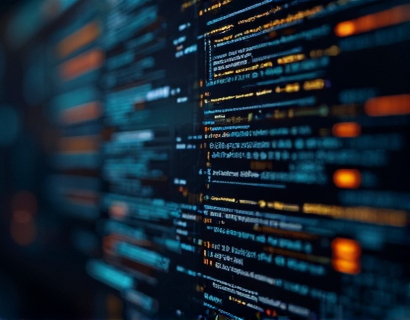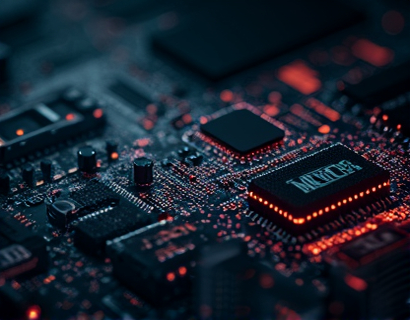Advanced Layer 2 Solutions: Revolutionizing Blockchain Scalability and Efficiency for EVM-Enabled Development
In the rapidly evolving landscape of blockchain technology, scalability and efficiency have emerged as critical challenges for developers, especially those working with Ethereum Virtual Machine (EVM)-enabled platforms. The inherent limitations of Layer 1 blockchains, such as limited transaction throughput and high gas fees, have spurred the development of advanced Layer 2 solutions. These solutions aim to enhance scalability, security, and efficiency, enabling the creation of faster, more secure, and cost-effective decentralized applications (dApps). This article delves into the transformative impact of advanced Layer 2 solutions on EVM-based blockchain development, providing insights for blockchain developers and innovators.
Understanding Layer 2 Solutions
Layer 2 solutions refer to technologies built on top of existing blockchain networks (Layer 1) to improve performance and reduce costs. Unlike Layer 1 upgrades, which require consensus changes and can be complex and time-consuming, Layer 2 solutions offer a more agile and flexible approach. These solutions process transactions off the main blockchain, aggregating them into a single transaction that is then submitted to the Layer 1 network. This off-chain processing significantly reduces the load on the main chain, leading to faster transaction times and lower fees.
Key Advantages of Advanced Layer 2 Solutions
One of the primary benefits of advanced Layer 2 solutions is enhanced scalability. By handling a larger volume of transactions off the main blockchain, these solutions can process thousands of transactions per second, compared to the few十 per second capability of many Layer 1 blockchains. This scalability is crucial for dApps that require high throughput, such as gaming platforms, social networks, and financial applications.
Security is another critical aspect where advanced Layer 2 solutions excel. While off-chain transactions may seem more vulnerable, reputable Layer 2 protocols implement robust security measures. For instance, state channels and sidechains use cryptographic techniques to ensure that transactions are secure and irreversible once they are settled on the main chain. This dual-layer security model minimizes the risk of fraud and ensures that users can transact with confidence.
Cost efficiency is perhaps the most immediate benefit for developers and users alike. Gas fees on Layer 1 blockchains can be prohibitively expensive, especially during peak times. Layer 2 solutions significantly reduce these costs by offloading transaction processing, making it feasible to build and maintain dApps that were previously economically unviable on main chains.
Popular Layer 2 Protocols for EVM-Enabled Development
Several advanced Layer 2 protocols have gained prominence for their compatibility with EVM-based development. These protocols leverage the security and smart contract capabilities of Ethereum while addressing its scalability limitations.
One such protocol is **Optimistic Rollups**. Optimistic Rollups bundle multiple transactions into a single transaction on the main chain, using a trust-minimizing approach to validate transactions. If any transaction is found to be invalid, the rollup operator is penalized, ensuring the integrity of the system. This method allows for high transaction throughput while maintaining strong security guarantees. Developers can deploy smart contracts on Optimistic Rollups, benefiting from faster transaction times and lower fees without compromising on security.
Another notable solution is **Zero-Knowledge Rollups** (ZK Rollups). ZK Rollups use zero-knowledge proofs to bundle and verify transactions off-chain, providing even higher scalability and faster finality compared to Optimistic Rollups. The cryptographic proofs ensure that all transactions are valid, and the main chain only verifies the aggregated proof, further reducing the computational load. This makes ZK Rollups ideal for applications requiring high performance and low latency.
**Sidechains** are another Layer 2 solution that has gained traction. Sidechains are separate blockchains that are linked to the main chain through a two-way peg, allowing assets to be transferred between the two. Sidechains can be customized to optimize for specific use cases, such as higher transaction speeds or lower fees. For EVM-based development, sidechains can run custom versions of the Ethereum virtual machine, enabling developers to create tailored solutions for their dApps.
Integrating Layer 2 Solutions with EVM-Based Development
Integrating advanced Layer 2 solutions into EVM-based development requires a strategic approach. Developers must consider the specific use case and performance requirements of their dApps to choose the most suitable Layer 2 protocol. Here are some key steps and considerations for seamless integration:
First, understand the capabilities and limitations of the chosen Layer 2 protocol. For instance, Optimistic Rollups are well-suited for applications that require high throughput and can tolerate a slight delay in finality, while ZK Rollups are ideal for use cases demanding immediate confirmation and higher security.
Second, leverage existing development tools and libraries. Most Layer 2 protocols provide comprehensive SDKs and integration guides to facilitate the development process. These tools simplify the deployment of smart contracts and the handling of off-chain transactions, reducing the complexity for developers.
Third, ensure robust testing and validation. Given the off-chain nature of transactions, it is crucial to thoroughly test the interaction between on-chain and off-chain components. This includes simulating various scenarios to ensure that the system behaves as expected and that security measures are effective.
Finally, consider the governance and maintenance aspects of the Layer 2 solution. Active community support and regular updates are essential for the long-term success and security of the dApp. Engaging with the community and staying informed about protocol improvements can help developers stay ahead of potential issues.
Use Cases and Future Prospects
The applications of advanced Layer 2 solutions are vast and varied. In the realm of finance, decentralized exchanges (DEXs) and lending protocols can benefit significantly from the reduced fees and increased transaction speeds. Gaming platforms can offer seamless in-game transactions and asset transfers, enhancing user experience and engagement. Social media platforms can implement Layer 2 solutions to handle high volumes of user interactions without compromising on performance.
Looking ahead, the evolution of Layer 2 technologies is expected to continue at a rapid pace. Innovations such as **Layer 2.5** solutions, which combine elements of both Layer 1 and Layer 2, promise to further enhance scalability and interoperability. The development of cross-chain Layer 2 solutions will enable seamless interaction between different blockchain ecosystems, opening up new possibilities for decentralized applications.
Moreover, the integration of advanced Layer 2 solutions with emerging technologies like artificial intelligence and the Internet of Things (IoT) will drive new use cases and applications. As the blockchain ecosystem matures, the role of Layer 2 solutions in shaping the future of decentralized technologies will become increasingly significant.
In conclusion, advanced Layer 2 solutions are revolutionizing blockchain scalability and efficiency, particularly for EVM-based development. By addressing the inherent limitations of Layer 1 blockchains, these solutions enable the creation of faster, more secure, and cost-effective dApps. For blockchain developers and innovators, embracing Layer 2 technologies is not just an option but a necessity for building the next generation of decentralized applications.










































